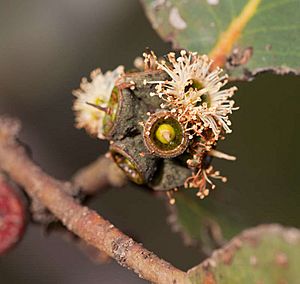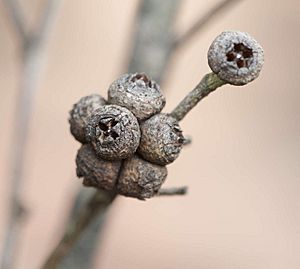Grampians stringybark facts for kids
Quick facts for kids Grampians stringybark |
|
|---|---|
 |
|
| Flower of Eucalyptus serrawnsis | |
| Scientific classification | |
| Genus: |
Eucalyptus
|
| Species: |
serraensis
|
The Eucalyptus serraensis, commonly called the Grampians stringybark, is a special type of small tree or a mallee. A mallee is a type of eucalyptus that grows many stems from a large underground rootstock. This plant is found only in the Grampians area of Victoria, Australia. It has rough, stringy bark on its trunk and sometimes on its branches too. The bark higher up is smooth. Its leaves can be shaped like a spear, an egg, or even round. Its flower buds grow in groups of three or seven and have no stalks. The flowers are white, and the fruit is shaped like a half-sphere or a cup.
What it Looks Like
The Grampians stringybark typically grows up to about 5 meters (16 feet) tall. It has a special woody swelling at its base called a lignotuber. This helps the plant regrow after a fire. Its bark is rough and stringy on the trunk and sometimes on the lower branches. Higher up, the bark is smooth and can be pale grey or brownish.
Young plants and new shoots that grow after damage (called coppice regrowth) have shiny green leaves. These leaves are egg-shaped to round, about 4.4 to 7 centimeters (1.7 to 2.8 inches) long and 4.5 to 5.8 centimeters (1.8 to 2.3 inches) wide.
Adult leaves are shiny green on both sides. They can be round, egg-shaped, oval, or spear-shaped. They are usually 5 to 13 centimeters (2 to 5 inches) long and 2 to 7 centimeters (0.8 to 2.8 inches) wide. These leaves grow on a stalk called a petiole, which is about 1 to 3 centimeters (0.4 to 1.2 inches) long.
The flower buds grow in the axils of the leaves. An axil is the angle between a leaf and the stem. The buds appear in groups of three or seven on a short stalk, or peduncle, which is up to 3 millimeters (0.1 inches) long. Each bud sits directly on this stalk without its own little stem, which means they are sessile.
Mature buds look warty and are oval to round. They are about 6 to 15 millimeters (0.2 to 0.6 inches) long and 5 to 10 millimeters (0.2 to 0.4 inches) wide. Each bud has a cap, called an operculum, which can be cone-shaped, rounded, or flat.
This plant flowers from April to November, and its flowers are white. After flowering, it produces a woody fruit. This fruit is a capsule that is sessile (has no stalk). It is shaped like a half-sphere or a cup, about 6 to 17 millimeters (0.2 to 0.7 inches) long and 10 to 20 millimeters (0.4 to 0.8 inches) wide. The parts that open to release the seeds, called valves, usually stick out from the fruit.
How it Got its Name
The Grampians stringybark was first officially described in 1993. Two scientists, Pauline Ladiges and Trevor Paul Whiffin, wrote about it in a scientific journal called Australian Systematic Botany. They based their description on a plant found near Sundial Turntable in Grampians National Park.
The second part of its scientific name, serraensis, tells us where it lives. It refers to the Serra Range in Victoria, which is part of the Grampians where this plant is found.
Where it Lives
The Grampians stringybark grows in very rocky places. You can find it on the Serra and Wonderland Ranges, both located within the Grampians National Park.


